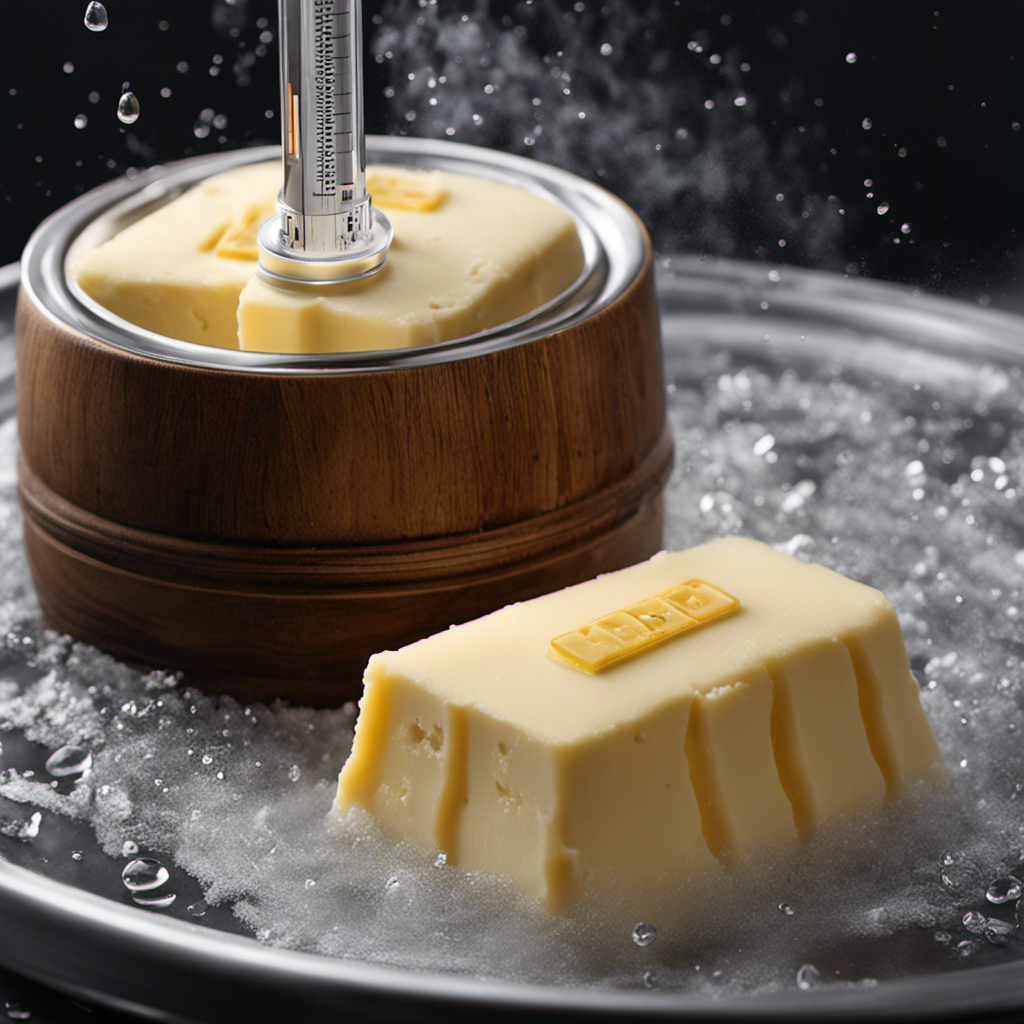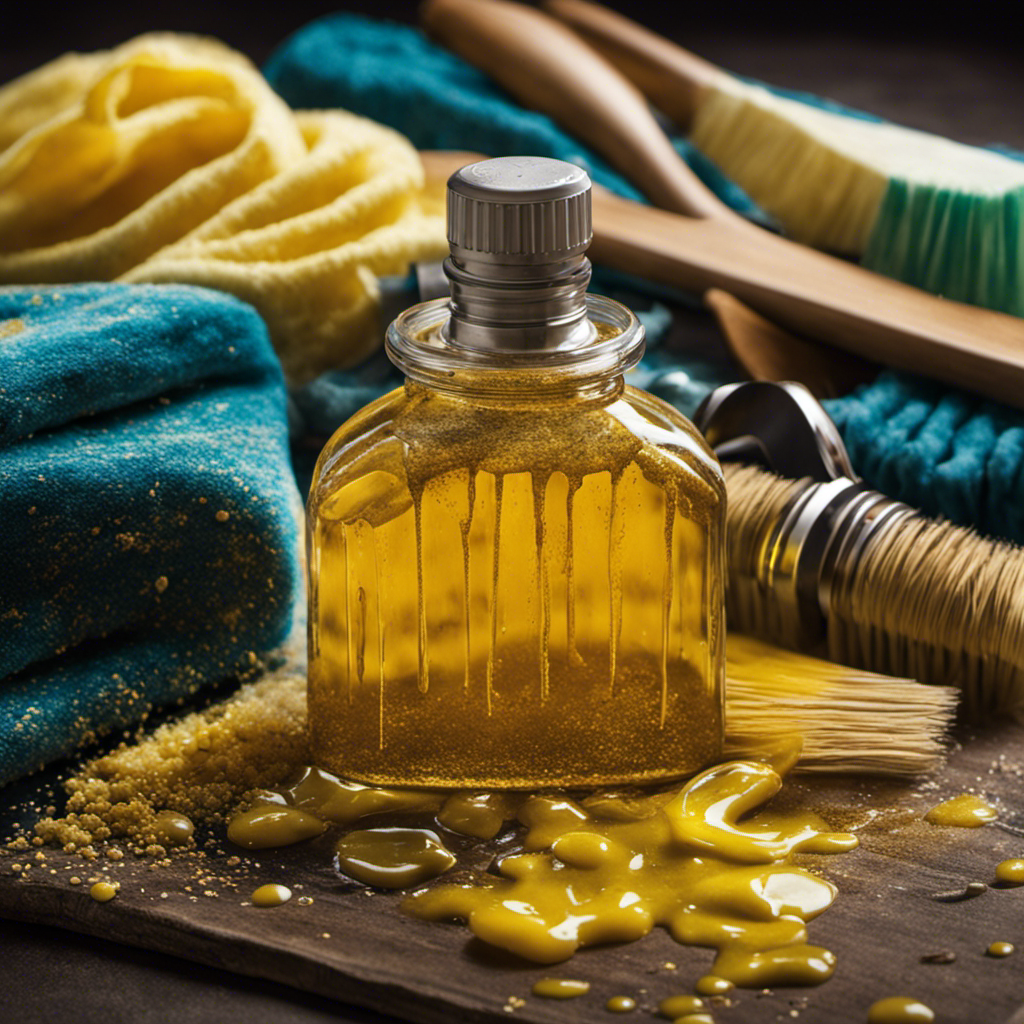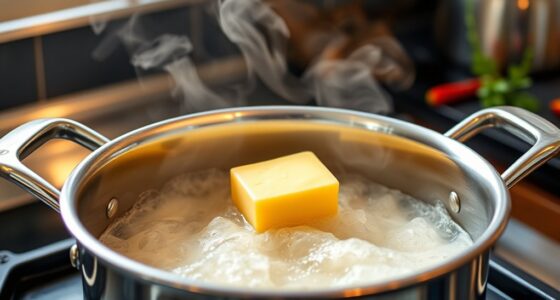Have you ever found yourself in the midst of a baking endeavor, only to discover that your butter is as solid as a rock? No need to fret, I’ve got you covered.
In this article, I’ll show you the best methods for getting frozen butter to room temperature in no time. From thawing in the fridge to using a water bath or microwave, I’ll walk you through each step to ensure your butter is perfectly soft and ready to use.
Let’s get started!
Key Takeaways
- Thawing butter in the fridge maintains quality and texture, preventing uneven melting and reducing the risk of bacterial growth.
- Alternative thawing methods include using a microwave with caution, leaving the butter on the countertop in a butter dish, or using a water bath technique.
- When using a microwave, follow recommended time guidelines and use a low power level to achieve the desired consistency without melting the butter completely.
- Kitchen appliances such as hot water or a blow dryer can also be used to soften frozen butter, but caution should be taken to avoid overheating and melting the butter.
The Importance of Room Temperature Butter
Room temperature butter is crucial for achieving the perfect texture in baking recipes. When butter is at room temperature, it is soft and spreadable, making it easier to cream with sugar and incorporate air into the batter. This results in a lighter and fluffier final product.
Cold butter, on the other hand, does not mix well with other ingredients and can lead to a dense and heavy texture. To ensure that your butter is soft and spreadable, there are a few tips you can follow.
Firstly, remove the butter from the refrigerator and let it sit at room temperature for about 30 minutes before using. Alternatively, you can microwave the butter for a few seconds at a time, checking regularly to ensure it doesn’t melt. Another trick is to grate the cold butter using a cheese grater, which helps it soften quickly.
Planning Ahead: Thawing Butter in the Fridge
When it comes to thawing food, I always prefer using the fridge method. Thawing in the fridge offers several benefits, such as maintaining the food’s quality and reducing the risk of bacterial growth.
The time required for thawing in the fridge varies depending on the size and type of food, but generally, it’s a slower process that requires some patience. However, if you’re short on time, there are alternative thawing methods like using cold water or the microwave, although they may not yield the same results as fridge thawing.
Benefits of Fridge Thawing
To get your frozen butter to a spreadable consistency, you can speed up the process by thawing it in the fridge overnight. Thawing butter in the fridge offers several benefits that make it an ideal method. Firstly, it ensures a gradual thawing process, which helps to maintain the quality and texture of the butter. Unlike thawing at room temperature or using a microwave, the fridge thawing method prevents the butter from becoming too soft or melting unevenly. Secondly, it reduces the risk of bacterial growth, as the controlled temperature of the fridge inhibits the growth of harmful bacteria. Additionally, thawing butter in the fridge allows you to plan ahead and conveniently have soft, ready-to-use butter whenever you need it. Here is a table summarizing the benefits of fridge thawing:
| Benefits of Fridge Thawing |
|---|
| Gradual thawing process |
| Maintains quality and texture |
| Prevents uneven melting |
| Reduces risk of bacterial growth |
| Convenient and ready-to-use butter |
Thawing butter in the fridge is not only practical but also ensures that your butter is soft and spreadable, ready to enhance the flavors of your favorite recipes.
Time Required for Thawing
If you’re in a hurry, the quickest way to thaw your butter is by using the microwave.
But if you have a little more time and want to avoid any potential splattering, here’s a time-saving tip: use a butter dish.
Simply place the frozen butter in a butter dish and leave it on the countertop for about 30 minutes to an hour. The time required for thawing will depend on the temperature of your kitchen. If it’s warmer, the butter will thaw more quickly. Just make sure to keep an eye on it and test the consistency with a butter knife before using.
Using a butter dish not only saves time, but it also allows the butter to thaw evenly and at a controlled pace.
Alternative Thawing Methods
For quicker thawing, you can try using the microwave or leaving it in a bowl of warm water. However, if you prefer alternative thawing techniques, using a butter dish can be a great option.
Here are five steps to effectively thawing frozen butter using a butter dish:
-
Take a butter dish and place the frozen butter inside. Make sure the dish is deep enough to hold the butter without any spillage.
-
Cover the dish with a lid or plastic wrap to prevent any contaminants from getting into the butter.
-
Leave the dish on the counter at room temperature for about 1-2 hours. The butter will gradually thaw and reach room temperature.
-
After the butter has thawed, give it a gentle stir to ensure it is evenly softened.
-
Use the softened butter in your desired recipe or store it in an airtight container in the refrigerator.
Using a butter dish is a simple and effective way to thaw frozen butter, providing you with room temperature butter whenever you need it.
Quick Thawing Methods: Water Bath Technique
The quickest way to thaw frozen butter is by using the water bath technique. This method involves placing the wrapped butter in a bowl of warm water for a few minutes until it softens.
However, it is important to take certain safety precautions when using this method. Firstly, make sure the water is not too hot as it can melt the butter. Secondly, always keep the butter wrapped tightly to prevent water from seeping in and compromising its quality.
To maintain the butter’s quality during thawing, it is recommended to use a waterproof bag or wrap multiple layers of plastic wrap around the butter. This will prevent any water from coming into contact with the butter.
Transitioning into the subsequent section, another popular method for rapidly softening butter is using a microwave.
Using a Microwave for Rapid Butter Softening
When it comes to rapidly softening butter using a microwave, it’s important to follow the recommended time guidelines to achieve the desired consistency without melting it completely.
To ensure the perfect texture, it’s crucial to pay attention to how the butter looks and feels after microwaving.
In case you don’t have a microwave or prefer alternative methods, there are other options available for softening butter efficiently.
Microwave Time Guidelines
To defrost your frozen butter, you can use the microwave, but be careful not to overheat it. The key is to find the right balance between melting the butter and getting it to room temperature. Here are some guidelines to help you achieve that:
- Start by setting your microwave to a low power level, around 30-40%. This will ensure a gradual and even thawing process.
- Place the frozen butter in a microwave-safe bowl or plate. Make sure to cut it into smaller pieces for faster and more even thawing.
- Microwave the butter in short bursts, typically 10-15 seconds at a time. Check its consistency after each interval to prevent overheating.
- Keep in mind that the melting point of butter is around 90-95°F (32-35°C). Aim to warm the butter to a temperature close to this range.
- Stir the butter occasionally during the microwaving process to distribute the heat evenly.
Butter Texture After Microwaving
After microwaving, the texture of the butter may become softer and more spreadable. This is because microwaving raises the temperature of the butter, causing it to reach its melting point. The melting point of butter is around 32 to 35 degrees Celsius (90 to 95 degrees Fahrenheit).
When the butter melts, its consistency changes from solid to liquid, making it easier to spread on bread or toast. The heat from the microwave helps to break down the structure of the butter, allowing it to become more pliable.
However, it’s important to be cautious when microwaving butter, as it can quickly go from solid to completely melted. It’s best to microwave the butter in short bursts, checking its consistency frequently to ensure it doesn’t become too runny.
Alternative Butter Softening Methods
Another way to soften butter quickly is by using the microwave. This method is perfect for when you need softened butter in a hurry. Here are some alternative butter softening techniques that you can try:
-
Grate the frozen butter: Using a box grater, grate the frozen butter into small pieces. This increases the surface area and helps it soften faster.
-
Pound it: Place the frozen butter between two sheets of wax paper and pound it with a rolling pin. The pressure will help break it down and soften it.
-
Warm water bath: Fill a bowl with warm water and place the wrapped butter in it. The heat from the water will gradually soften the butter.
-
Use a warm oven: Preheat your oven to the lowest temperature setting. Place the wrapped butter in the oven for a few minutes until it starts to soften.
-
Use a cheese grater: Similar to grating, you can also use a cheese grater to shave thin slices of frozen butter. These thin slices will soften much faster.
By using these creative ways to soften butter faster, you can save time and still achieve the desired consistency.
Now, let’s explore other methods of softening butter with kitchen appliances.
Softening Butter With Kitchen Appliances
Using a microwave is a quick and efficient way to soften butter from its frozen state. However, there are other kitchen appliances that can also be used for butter softening.
One alternative method is to use hot water. To do this, you can fill a bowl with hot water and let it sit for a minute to warm up the bowl. Then, pour out the water and place the frozen butter in the warm bowl. The residual heat will gradually soften the butter without melting it completely.
Another option is to use a blow dryer. Simply set the blow dryer to its lowest heat setting and aim it at the butter. Move the blow dryer back and forth to evenly distribute the heat. Be careful not to overheat the butter, as this can cause it to melt.
Room Temperature Hacks: Speeding up Butter Softening
To speed up softening, you can try placing the wrapped butter in a sealed plastic bag and gently kneading it with your hands. This helps to distribute the heat and allows the butter to come to room temperature faster.
However, if you don’t have the time or patience for this method, there are other alternatives and creative room temperature hacks you can try. Here are five options to consider:
-
Microwave method: Unwrap the butter and place it in a microwave-safe bowl. Heat it in short bursts of 10-15 seconds, checking and stirring in between, until it reaches the desired softness.
-
Grated butter: Use a box grater to grate frozen butter directly into your recipe. The smaller pieces will soften quicker.
-
Warm water bath: Fill a bowl with warm water and place the wrapped butter in it. Let it sit for a few minutes until softened.
-
Oven method: Preheat your oven to its lowest temperature, then turn it off. Place the wrapped butter on a heatproof plate and leave it in the warm oven for a few minutes.
-
Butter warmer: If you have a butter warmer or melter, use it to gently heat the butter until softened.
With these butter softening alternatives and room temperature hacks, you can quickly and conveniently bring your frozen butter to the ideal consistency for baking or spreading.
Tips for Storing Softened Butter Safely
When storing softened butter, make sure to tightly seal the container to prevent any air from getting in and causing it to spoil. This is an important step in ensuring that your butter stays fresh and safe to use. In addition to properly sealing the container, there are other alternatives you can consider for storing butter at room temperature. Some popular options include using a butter dish with a lid, using a butter keeper or crock, or even using a butter bell. These containers are designed to keep the butter at the perfect temperature and prevent it from spoiling. They are also convenient and easy to use. Here is a table that compares the different methods of storing softened butter:
| Method | Pros | Cons |
|---|---|---|
| Butter Dish | Easy to use and access | Butter can spoil if not sealed |
| Butter Keeper/Crock | Keeps butter fresh for longer periods | Takes up counter space |
| Butter Bell | Provides a decorative storage option | Requires regular maintenance |
Frequently Asked Questions
Can I Use Frozen Butter Straight From the Freezer in My Recipe?
I wouldn’t recommend using frozen butter straight from the freezer in your recipe. Thawing butter is essential for proper incorporation and texture. However, there are alternatives to room temperature butter that can be used in certain recipes.
How Long Does It Take for Butter to Reach Room Temperature When Left on the Countertop?
It usually takes about 1-2 hours for butter to reach room temperature on the countertop. To soften butter quickly, you can microwave it in short bursts or use a grater to shred frozen butter.
Can I Use a Hairdryer or Heat Gun to Soften Frozen Butter Quickly?
Using a hairdryer or heat gun to soften frozen butter quickly is not recommended. It can cause uneven heating and potentially melt the butter. There are safer alternative methods to thaw butter efficiently.
Is It Safe to Thaw Butter in the Microwave?
Thawing butter safely is important. Microwaving can be risky due to uneven heating. Alternatives include grating frozen butter or leaving it at room temperature for a while.
What Is the Best Way to Store Softened Butter for Future Use?
The best way to soften butter for baking is to leave it at room temperature for about 30 minutes. To store softened butter, you can shape it into a log or place it in an airtight container in the refrigerator for up to a month.
Conclusion
In conclusion, getting frozen butter to room temperature is a breeze with these helpful tips and tricks.
By planning ahead and thawing butter in the fridge, you can ensure a smooth and even softening process.
If you’re in a hurry, the water bath technique or using a microwave can come to the rescue.
Don’t forget about the convenient option of using kitchen appliances to soften your butter quickly.
And for those looking to save time, room temperature hacks will do the trick.
Remember, storing softened butter safely is key, so be sure to follow the proper guidelines.
With these techniques, you’ll never have to wait for butter to soften again!
So go ahead, give them a try and enjoy your perfectly softened butter in no time!









